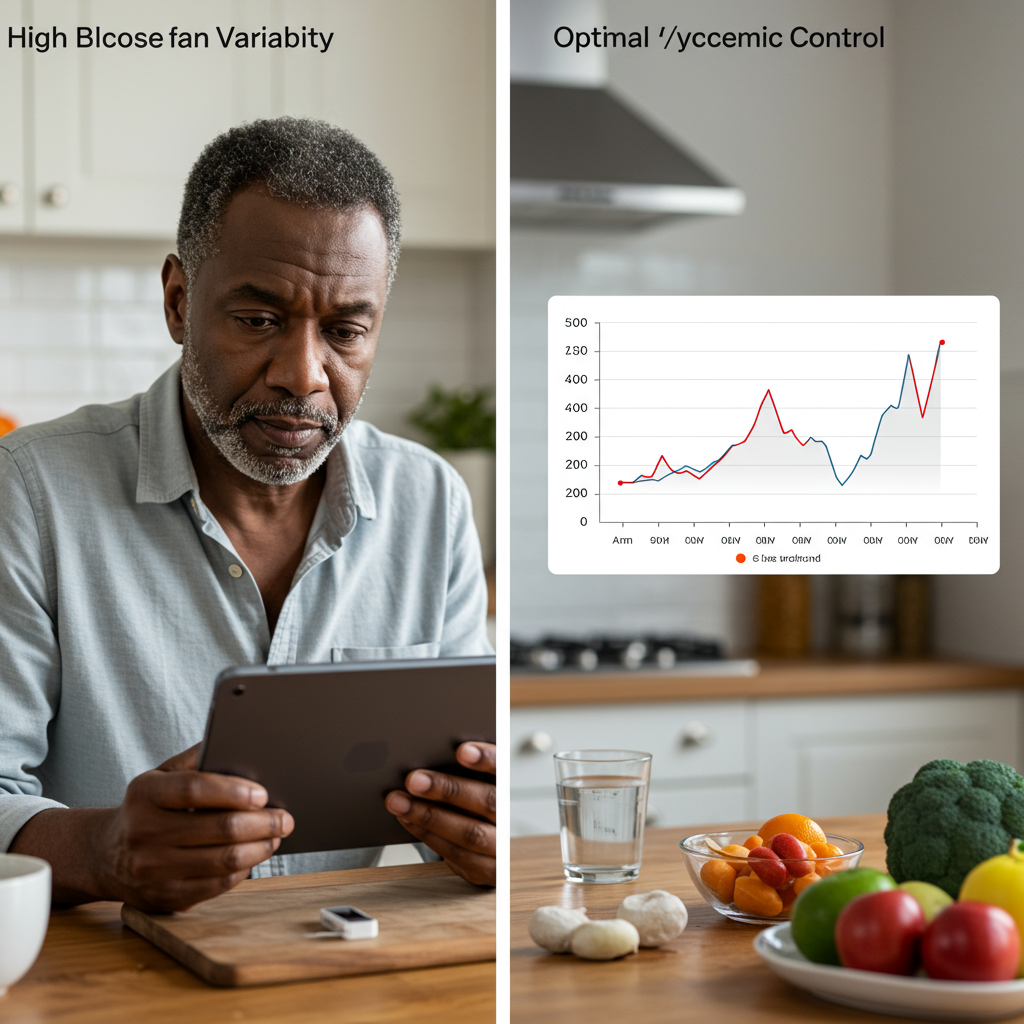Če ste spremljali pogovore o sladkorni bolezni, ste verjetno seznanjeni s HbA1c kot zlatim standardom za merjenje glikemične kontrole. Toda kaj, če vam povem, da nam morda manjka ključni del sestavljanke presnovnega zdravja? Nedavne raziskave nakazujejo, da je variabilnost krvnega sladkorja—kako močno nihajo ravni glukoze čez dan—lahko prav tako pomembna (ali celo pomembnejša) od povprečne vrednosti krvnega sladkorja pri določanju dolžine in kakovosti življenja.
Problem z "vlakcem smrti" krvnega sladkorja
Mnogi posamezniki, celo tisti z "normalno" vrednostjo HbA1c, doživljajo izrazite glikemične izpade čez dan. Ti tihi vzponi in padci lahko sprožijo vrsto škodljivih bioloških procesov, ki lahko pospešijo staranje in povečajo tveganje za bolezni, tudi če sladkorna bolezen ni diagnosticirana.
Ko krvni sladkor hitro naraste (po obroku), lahko povzroči:
- Oksidativni stres: Proizvodnja prostih radikalov se občutno poveča, kar poškoduje celične komponente
- Glikacijo: Molekule glukoze se neprimerno vežejo na beljakovine in tvorijo napredne končne produkte glikacije (AGEs)
- Endotelno disfunkcijo: Notranja plast krvnih žil je poškodovana, kar je predhodnica ateroskleroze
- Sistemsko vnetje: Telesni vnetni odziv postane kronično aktiviran
Zaskrbljujoče je predvsem to, da se ti procesi lahko pojavijo tudi, če je vaša povprečna vrednost krvnega sladkorja (merjena s HbA1c) povsem v mejah normale. Zato merjenje variabilnosti glikemije daje bolj popolno sliko presnovnega zdravja.

Nove dokazi o vplivu variabilnosti krvnega sladkorja na dolgoživost
Več sklopov dokazov zdaj nakazuje, da je variabilnost krvnega sladkorja lahko neodvisen dejavnik tveganja za umrljivost in bolezni, povezane s starostjo:
-
Kardiovaskularni izidi: Študije so pokazale, da imajo posamezniki z večjo glikemično variabilnostjo višje stopnje kardiovaskularnih dogodkov, neodvisno od povprečnega krvnega sladkorja. Vsak 1 mmol/L povečanja variabilnosti lahko poveča tveganje za kardiovaskularno smrtnost za 20–30%.
-
Kognitivni upad: Večja variabilnost je povezana s pospešenim kognitivnim staranjem in večjim tveganjem za demenco. Možgani so še posebej občutljivi na nihanja glukoze, kar lahko oslabi delovanje nevronov in pospeši nevrodegeneracijo.
-
Umrljivost iz vseh vzrokov: Morda najbolj prepričljivo, raziskave so pokazale, da večja variabilnost glukoze napoveduje splošno smrtnost tako pri diabetikih kot nediabetikih, kar nakazuje njeno vlogo kot temeljni dejavnik staranja.
-
Celična senescenca: Na celični ravni variabilnost glukoze pospeši senescenco—proces, kjer se celice prenehajo deliti in začnejo izločati vnetne spojine—učinkoviteje kot dolgotrajno povišan sladkor.
Mehanistične poti postajajo vse bolj jasne: variabilnost glikemije povzroča več žilnih poškodb in oksidativnega stresa kot trajna hiperglikemija, ker se antioksidativni obrambni sistem ne more dovolj hitro prilagajati hitrim nihanjem glukoze.
Prevzem nadzora: Praktične strategije za zmanjšanje variabilnosti krvnega sladkorja
Dobra novica je, da je variabilnost krvnega sladkorja zelo prilagodljiva z življenjskimi intervencijami. Tukaj so z dokazi podprti pristopi za izravnavo glikemičnih krivulj:
Sestava in časovno razporejanje obrokov:
- Beljakovine in vlaknine zaužijte pred ogljikovimi hidrati v obroku
- Razmislite o časovno omejenem hranjenju, da zmanjšate nočne skoke glukoze
- Izogibajte se uživanju samotnih ogljikovih hidratov, še posebej rafiniranih ogljikovih hidratov in sladkorja

Strategije gibanja:
- Po obroku naredite 10–15 minutni sprehod
- Pred obroki, ki vsebujejo ogljikove hidrate, vključite kratke vaje za moč (tudi le počepi z lastno težo ali sklece ob steni)
- Prekinite dolgotrajno sedenje z gibalnimi odmori vsakih 30–45 minut
Dopolnilni pristopi:
- Berberin (500–1500 mg dnevno) kaže obetavne učinke na povsem obrokovno glukozo
- Jabolčni kis (1–2 žlici) pred obroki, ki vsebujejo ogljikove hidrate
- Magnezij (200–400 mg dnevno) lahko izboljša občutljivost na inzulin
Napredno spremljanje:
- Upoštevajte možnost uporabe stalnega merilnika glukoze (CGM), tudi če niste diabetik
- Spremljajte meritve variabilnosti glikemije (standardni odklon, koeficient variacije)
- Prepoznajte osebne sprožilce glukoze preko sistematičnega samospremljanja
Lepota osredotočanja na variabilnost glikemije je, da so izboljšave lahko vidne hitro, pogosto že v nekaj dneh po uvedbi teh strategij. Še pomembneje, zmanjšana variabilnost lahko prinese koristi za dolgoživost, ki segajo daleč preko preprečevanja diabetesa.
Zaključek: Nova paradigma presnovnega zdravja
Ko še naprej razvozlavamo zapleten odnos med presnovo in staranjem, se variabilnost krvnega sladkorja izkaže za ključen biomarker in tarčo intervencij. Poleg preprostega izogibanja diabetesa je optimizacija za stabilne ravni glukoze čez dan morda eno najmočnejših orodij za podaljšanje tako dolgoživosti kot obdobja zdravja.
Dokazi nakazujejo, da bi morali svojo pozornost preusmeriti z občasnih meritev glukoze na tešče ali četrtletnih testov HbA1c na bolj dinamično razumevanje presnovnega zdravja. Če damo prednost glikemični stabilnosti—torej ravnim in mirnim krivuljam glukoze—lahko upočasnimo procese staranja že v njihovem bistvu.
Vprašanje ni več le "Kakšen je tvoj krvni sladkor?", temveč "Kako stabilen je tvoj krvni sladkor čez dan?" Vaš odgovor lahko določi ne le, kako dolgo boste živeli, temveč tudi kako kakovostno boste preživeli ta leta.

Reference:
-
Ceriello A, Monnier L, Owens D. Glikemična variabilnost pri sladkorni bolezni: klinične in terapevtske implikacije. The Lancet Diabetes & Endocrinology. 2019;7(3):221-230.
-
Hirsch IB, Brownlee M. Ali bi morala minimalna variabilnost krvnega sladkorja postati zlati standard glikemične kontrole? Journal of Diabetes and its Complications. 2005;19(3):178-181.






